Perhaps the greatest mystery to people who are contemplating traveling by RV, or are now guests on someone else’s RV, is how the RV toilet works. How it operates, how it flushes, where “it” goes when you flush it, and what you do with it are questions on the minds of potential RVers everywhere!
We’re here to demystify one of the many great benefits of traveling by RV – the private bathroom you can use while on the road and when in the middle of nowhere.
Can You Poop in An RV Toilet?
Of course, you can! But, if you’re unfamiliar with how mobile or portable camping toilets work, the concept of the RV toilet can be intimidating. That’s why we’re tackling this subject – to bring to the forefront a discussion of the various types of RV toilets you may find yourself dealing with, and how they work. This way, regardless of the type of RV you find yourself traveling in, you’ll be well prepared.
Let’s get to it!
Types of RV Toilets
There are several types of RV toilets, and despite the fact that they all serve the very same purpose, they all work a little differently.
Some RV toilets use water, and others use no water at all. What’s a waterless toilet? Well, believe it or not, there’s more than one type of those as well. We’ll get to that further down in the post.
All RV toilets you encounter will be one of five varieties: gravity flush, macerating, composting, cassette, or portable. You can also expect that you’ll “use” all of these types of toilets the way you’ve always used a toilet! It’s what happens next that will differ from RV toilet to RV toilet.
Let’s take a look at each type and how they work.
Gravity Flush
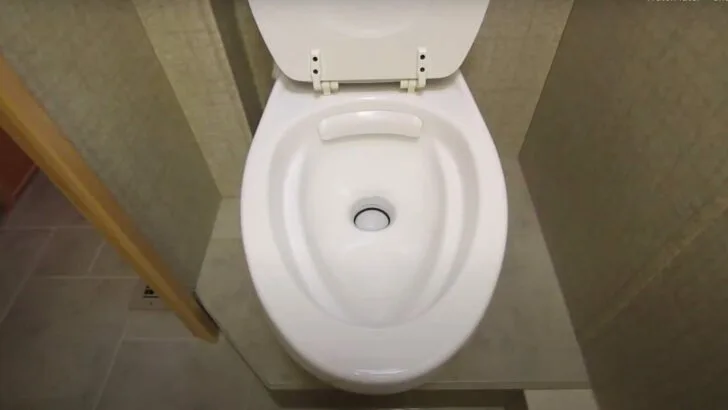
A gravity flush RV toilet operates pretty much like a toilet you would find in most modern buildings.
A gravity flush toilet looks and operates very similar to a toilet you would find in a home.
But there are a couple of differences due to the fact that RVs are homes that move. If RV toilets were designed with tanks and bowls that stayed full of water all the time, like in a regular house, the water would slosh out during travel.
Another difference is that most RV toilets flush using a foot pedal rather than a hand lever.
There will be a very small amount of water that stays in the toilet bowl, as opposed to the half-bowl of water you often see in a regular toilet. That small amount of water covers a closed flap with a seal.
Once you’ve used the toilet, you’ll depress a foot pedal which will open the flap, and any waste and toilet paper will drop down into a tank that sits under the RV. This tank is called the “black water tank” or “wastewater tank” (read more about the RV black water tank). As you depress the foot pedal, your RV’s water pump introduces more water into the toilet bowl. A small number of gravity flush toilets have push-button electric flush mechanisms instead of a foot pedal.
This type of RV toilet is most like your home toilet in terms of operation. The difference is that once a certain amount of sewage has collected in the holding tank, you’ll need to dump the contents of the RV’s black tank at a dump station or a full hook-up RV park.
You’ll do this by connecting one end of an RV sewer hose to your tank’s outlet and the other end to the dump station’s inlet, then opening a valve on your RV that allows the contents of the tank to run into the sewer drain.
The most popular RV gravity flush toilets on the market today are made by Dometic or Thetford. There are a few different styles and heights available, but they all generally work in the manner just described.
Macerating RV Toilet
Gravity flush toilets have been the standard option RV manufacturers have used for many years. But the drawback to them is the fact that the toilet has to be installed directly above (or very close to directly above) the black tank for them to work properly. And that limits the options for where the bathroom can be placed in the floorplan.
The problem goes away, however, with a macerating RV toilet. Instead of using a wide-open connection between the toilet bowl and tank (like a gravity flush toilet requires), they have a set of blades that reduce the waste to a slurry when you flush. That liquified waste can then pumped to wherever the black tank is located.
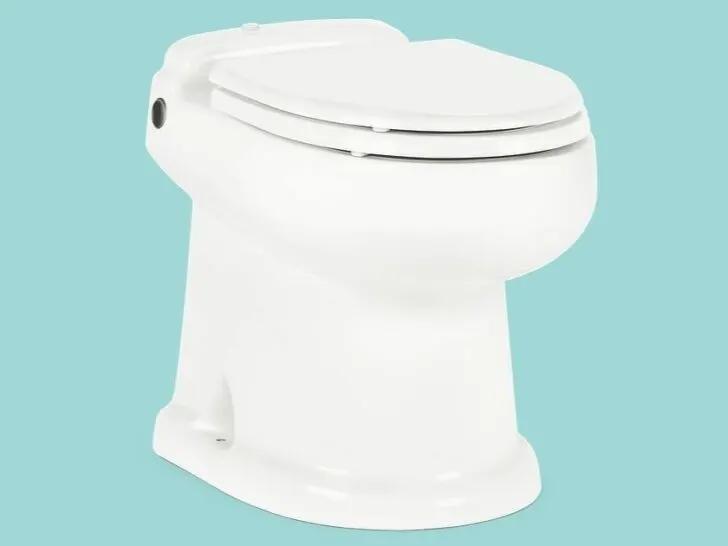
You wouldn’t know, to look at it, that this is a macerating RV toilet… or, necessarily, an RV toilet at all!
This flexibility has enabled RV manufacturers to arrange their floorplans how they’d like, without having to ensure the toilet is mounted directly above the tanks. So this is why it’s become more common to see rear bath, bath-and-a-half floorplans in motorhomes. They weren’t possible with just a gravity flush toilet.
The operation of a macerating toilet is very much like your household toilet. Once you’ve used the toilet, the press of a button (which can either be located on the toilet itself or mounted on the wall) triggers the flush cycle, automatically rinsing the contents of the bowl into the macerating blades, and running the pump the required length of time to ensure the results make it to the black tank.
Unlike with a gravity flush RV toilet, though, there’s no possibility for there to be an open connection between the bowl and the black tank, so macerating toilets have an advantage when it comes to reducing/eliminating odors.
But they do have a drawback. Because the macerated waste must be mixed with a sufficient amount of water to (1) be fluid enough to be pumped and (2) be a large enough volume to make it to wherever the black tank is located, they do use more water than any other type of toilet. So having one may reduce the amount of time you can dry camp.
If you’re interested in more information about macerating RV toilets, be sure to check out Tom & Cait Morton’s very thorough post on the subject: Pumping Your Poo: How Macerating Toilets Make RVs Better!
Composting Toilet
Another RV toilet you may encounter is a waterless toilet known as a composting toilet.
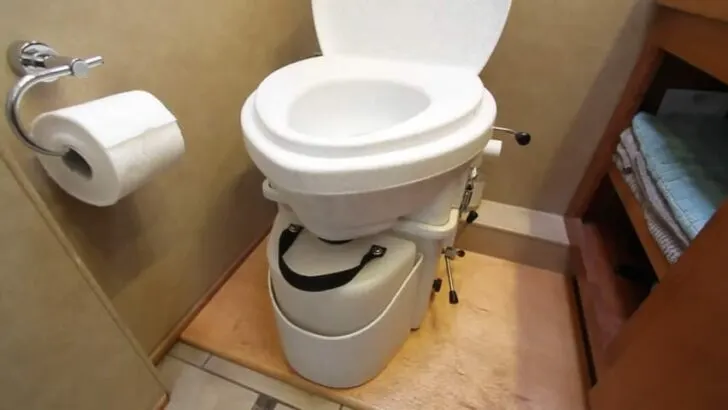
A composting toilet is great for boondocking because it uses none of your precious fresh water supply.
One of the great benefits of this type of toilet is the fact that it doesn’t use water from your fresh water tank. That’s particularly helpful for boondockers, since water conservation is key to camping off the grid.
Considering the amount of water flushing a toilet can use, this is one of the top considerations for RVers who switch to a composting toilet.
Most composting RV toilets use separate containers for liquid and solid waste. “Liquids” are deposited into a forward container attached to the front of the toilet, and “solids” are deposited into a separate area containing peat moss, sawdust, coconut fiber (also referred to as “coco coir”), or other similar media.
A primary reason why composting toilets are able to work without water and still emit little to no odor is due to this separation of liquid and solid waste. Another reason is that they also include a small 12V fan that vents gases outside of the RV.
The plastic bottle that collects liquids must be emptied into an appropriate location.
The larger composting bin containing the organic material sits at the back of, or under, the toilet to collect solid waste. After solid waste is deposited into the bin, rotate the handle to mix it with the organic matter. Eventually, the compost material is collected in a biodegradable bag or a plastic bag and thrown away.
The composting part of the toilet generally needs to be emptied every few weeks, depending on how many people are using it.
One important note for users of a composting toilet is that everyone needs to sit down to use it so that liquids and solids can each be diverted into their appropriate location.
Composting toilets are a great option, especially if you spend any significant amount of time boondocking. Not having to worry about filling up your black tank can really extend the length of time you can stay off the grid. If you’re interested, and want to learn more, check out The Morton’s post all about them: What’s So Great About RV Composting Toilets? (no, they aren’t fixated on toilets… they’re just thorough, LOL!)
Cassette Toilet
An RV cassette toilet has long been a popular RV toilet style in most of the world outside of North America, and is becoming more popular among Class B RV manufacturers in the U.S.
A cassette toilet is essentially a permanently installed toilet with a removable waste tank.
What RVers like most about the cassette toilet is the fact that the portable black/waste tank can be emptied into a dump station, without having to move the RV when the tank is full.
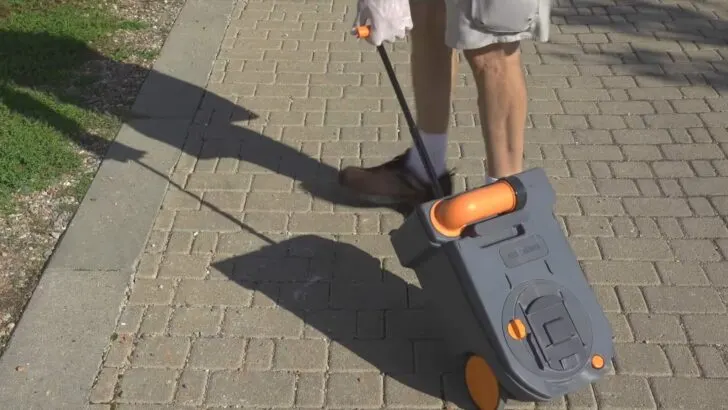
A cassette toilet has a portable waste tank which must be removed from the RV and emptied regularly.
Waste cassette sizes rarely exceed about four to five gallons in order to keep them light enough to handle when full. Of course, this smaller size requires them to be emptied more often. (Imagine your RV equipped with a 5-gallon black tank!)
Cassette toilets do use water to flush toilet contents into the portable waste tank. Bearing in mind that water weighs 8.34 pounds per gallon, you need to consider your ability to carry up to 40 pounds to the nearest dump point where it can be emptied. Some models of cassette toilets do have waste tanks with wheels and an extendable handle for rolling rather than carrying.
After using a cassette toilet, waste is stored in the cassette beneath the bowl.
Most cassette toilets have a button on the outside wall of the toilet that allows flushing using water. If the cassette toilet is a permanently mounted model, the water will likely be connected to the RV’s fresh water tank.
By contrast, a portable cassette toilet has its own water tank which you must refill whenever you empty your toilet contents.
In an RV with a permanently mounted cassette toilet, the portable waste tank can be accessed from a door on the outside of the RV, whereas the waste tank of a portable cassette toilet is removed/unhinged from the top of the toilet for emptying.
Cassette toilets need to be emptied regularly, generally every couple of days when used by two adults.
Portable RV Toilet
While some cassette toilets can be portable, there’s another type of portable RV toilet that you may encounter. These are very simple to use and easy to empty.
Like composting toilets, traditional portable RV/camping toilets are waterless. They can be used inside an RV or camper, or even in a tent.
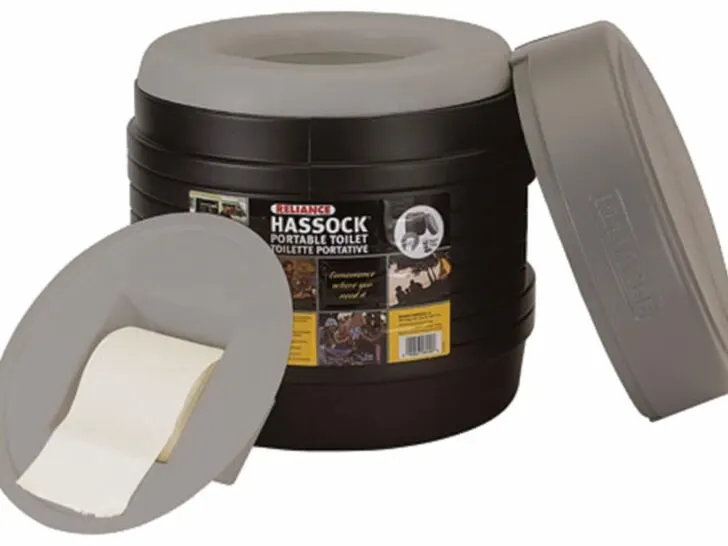
A waterless portable toilet is essentially a bucket with a plastic toilet seat on it.
A portable RV/camping toilet is essentially a bucket with a toilet seat. You’ll use this toilet just as you would your home toilet, however it will be lined with a plastic bag containing some type of liquid absorbent material. This may be a specially formulated compound that turns liquid into a gel (this is the most expensive option). Products such as Bio-Gel or Poo Powder serve this purpose.
More commonly, however, regular users of portable bucket-type toilets use materials such as pine pellets, kitty litter, or sawdust to cover and contain liquid and solid deposits between uses. These materials are far less expensive. A large bag lasts a long time and can be easily replenished at any Walmart or other big box store you encounter in your travels.
To use this type of RV toilet/camping toilet, you’ll line the bucket portion of the toilet with a good plastic bag (like Double Doodie Toilet Waste Bags) and put a shallow layer of your chosen material in the bottom. Once you’ve used the toilet you can put another layer over the top and continue to use the toilet in this manner.
The materials noted above expand and soak up liquids that do not need to be emptied right away. Some folks prefer to remove the bag once solid deposits have been made while others simply toss another layer of organic material over the top and continue using the toilet.
Either way, emptying the toilet consists of removing the plastic bag, tying the top, and depositing the bag wherever it is legal to dump trash (as with diapers).
Some campers choose to create their own portable toilets using a five-gallon bucket and a toilet seat, but there are several commercially available options.
How to Clean an RV Toilet
All RV toilets, including bucket-type toilets, need to have their surfaces cleaned regularly just like any household toilet.
What’s important is to use cleaning products that are compatible with the material used to make the toilet. For example, if you have a higher-end RV with a porcelain bowl, it can be cleaned in the same manner as a toilet in a “sticks and bricks” house.
If the toilet is made of any sort of plastic, be sure you don’t use anything that might harm it.
In all cases, you need to be aware that typical RV toilets have a seal on the gate valve that keeps the water in the bowl. That seal can be damaged if not treated carefully. It’s very important to keep that small amount of water in the bottom of the bowl since that’s what keeps odors from coming up out of the tank into the RV.
With composting toilets, the liquids bottle mounted at the front of the toilet must be dumped regularly and cleaned. Rinsing with vinegar can be helpful for preventing odors from accumulating. Over time, scale may build up on the inside of the liquids tank, requiring the use of a product to remove it, like CLR.
Top 5 RV Toilet Maintenance Tips
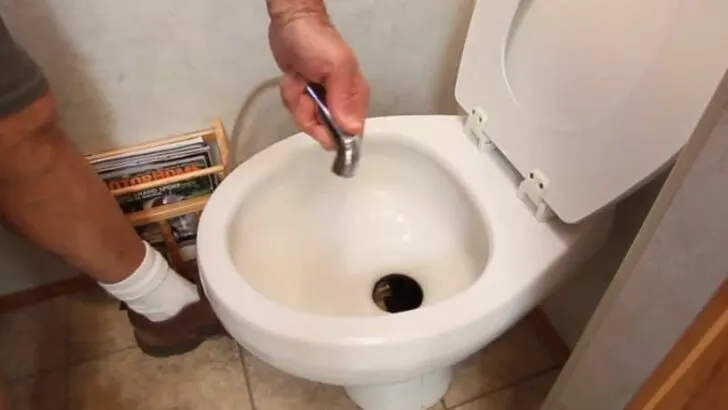
Using a product like Happy Campers helps to keep your toilet and tank as “fresh” as possible.
These five tips pertain to the most common type of RV toilet which is the gravity flush toilet.
- NEVER leave your black tank’s valve open, even when connected to a campground sewer. Doing so will allow the liquids to flow out of the black tank, leaving solids behind to pile up. This is one of the worst mistakes that a new RVer could make. The results can be so bad, they even have a name: “pyramiding”. ???? This condition will likely require the services of a professional to remedy. Luckily, it’s easily avoided by keeping the black valve closed.
- Use a product like Happy Campers organic holding tank treatment to control odors, and keep your toilet and tank as fresh as possible.
- Keep some water in the bowl of your RV toilet, covering the flap and seal. This will both block odors from coming up out of the tank into the RV, and keep the seal from drying out. Maintain/lubricate or replace your toilet’s seal as needed.
- Don’t use excessive amounts of toilet paper. If necessary, deposit toilet paper into a separate container to prevent large amounts from clogging things up. And only use RV-safe toilet paper. Contrary to popular belief, that doesn’t require special “RV” toilet paper. Lots of ordinary household toilet paper is RV safe. In a previous post, we demonstrated how to test your favorite toilet paper.
- Keep that toilet bowl clean! An RV toilet flush is not forceful so the toilet bowl may need some attention more regularly than at home.
Conclusion
Now that the mystery has been removed from all things related to RV toilets (and camping toilets in general), you’re open to all the possibilities of RVing. Whether you’re staying in a campground with full hook-ups or boondocking in the middle of nowhere, you’ll be confident that everything will go smoothly when nature calls.
Geek Out with Us Every Week
Join our newsletter to learn about all things RV-related. Every week we offer free tips, tricks, product reviews, and more to our online community of RVers. Whether this is your first time on the road or you’re a seasoned expert, we’d love for you to geek out with us!


Mark Falsafi
Thursday 16th of February 2023
Thank you. Very informative.
Susan E.
Friday 9th of April 2021
I wish I could purchase this video, as well as others. I have an Airstream that I rent on AirBnB and having videos like this available on the USB in the TV (as a sort of Welcome/How-To) would be super helpful.
Larry E McFadden
Saturday 26th of December 2020
As always excellent information, you guys do a great job and have helped me a lot! Thank you,
TheRVgeeks
Saturday 26th of December 2020
Good to hear... and thanks so much, Larry!
BB
Tuesday 28th of February 2017
I want to replace my RV toilet. The one in my coach isn't very deep and I would prefer one that's lower from the seat. Any models etc should I look for. It seems the ones that are advertised don't tell the inside depth.
TheRVgeeks
Tuesday 28th of February 2017
Hi BB,
Tough question. Generally, we've found that the all-plastic RV toilets tend to have a shallower/smaller bowl than the ceramic ones. Porcelain bowls are almost always nicer/deeper/larger. Our current toilet is a Thetford Aria Deluxe II... it's all porcelain and has an acceptably deep bowl that's much more like a traditional residential toilet (although still not quite as deep). The Aria Deluxe II is an electric-flush model (not a macerator, just an electrically-operated flush valve), so it might not work for your installation if you don't have 12V power handy near your current toilet... but they also make a more standard, pedal-flush model called the Thetford Aria Classic (see it here on Amazon: http://amzn.to/2lvMLqu ). It's described as an "elongated, deep bowl for more comfort"... and we've always liked it. Other than the flush mechanism, it's very much like a standard, elongated residential toilet.
Until we started looking around because of your question, we didn't even know the Aria Classic existed... and if we were to replace our existing toilet, we'd most likely replace it with that one. The electric flush on the Deluxe II works, but it's fairly loud when flushing and we'd prefer the relative silence of the pedal flush. Plus, the Deluxe II doesn't have a spray wand to assist flushing, which is a bit of a nuisance. We get around it by using a Solo cup to pour water down the bowl from the extra sink we have in our toilet room. But the Aria Classic comes with a sprayer wand... another plus in its favor. ;)
Our Aria Deluxe II is 9" deep, from the top surface of the bowl down to the top of the flush valve... and about 7" deep from the top surface of the bowl to the bottom of the bowl (before it drops down to where the flush valve sits). We assume the Aria Classic would have similar (if not identical) measurements, since it looks like the only real difference between them is the flush mechanism itself: Aria Deluxe II is a push-button, electrically-operated flush, while the Aria Classic is a standard foot pedal flush.
The Aria Classic is a fairly expensive toilet (at $650)... but looking online, Dometic offers the 320 Series (available here on Amazon: http://amzn.to/2lluStw ) that is also described as having "an elongated and deep ceramic bowl", but it's more reasonably priced ($206). It's a more-traditional RV-style toilet, but the bowl is ceramic, not plastic. It's also more likely to be available at a local RV Parts store (like Camping World) where you could see one in person to determine if the bowl depth is satisfactory.
Hope this helps.
Wildcherry
Wednesday 23rd of December 2015
Thank you for the presentation. Nicely done and with clear, understandable, pleasant, speaking instructions. I especially like the reminder of flushing BEFORE turning on the exhaust fan.
TheRVgeeks
Wednesday 23rd of December 2015
You only forget to turn that fan off once! LOL